 A research team led by Gary Kobinger from the Special Pathogen Program at the National Microbiology Laboratory in Winnipeg, Manitoba has developed a new antibody cocktail treatment that has proven effective in reducing the amount of deaths from Ebola hemorrhagic fever in a type of primate called a macaque. The treatment could prove useful in humans, too.
A research team led by Gary Kobinger from the Special Pathogen Program at the National Microbiology Laboratory in Winnipeg, Manitoba has developed a new antibody cocktail treatment that has proven effective in reducing the amount of deaths from Ebola hemorrhagic fever in a type of primate called a macaque. The treatment could prove useful in humans, too.
Human clinical trials for the new treatment may occur as early as 2014. The treatment targets the replication process of the virus and stops the infection from spreading. Since 1976 when the virus was first detected, the Centers for Disease Control and Prevention report that there have been over 30 different combined cases and incidents. The cases have ranged from one or two people being exposed in a hospital setting to regional outbreaks with over 400 people infected. In outbreak settings, deaths rates have ranged from 25 to 90%. Onset of the disease is fast and death can occur in several days to less than a month.
While no outbreaks have occurred in the United States, there have been isolated cases in the U.S. involving Ebola detection in quarantine facilities used to house imported monkeys from the Philippines. In one U.S. case, a human developed Ebola antibodies, which indicates direct exposure, but the individual did not become ill. Ebola is spread through direct contact with fluids or tissue of an infected human or other animal.
The majority of cases have occurred in remote African areas. There are currently two outbreaks occurring, one in the Democratic Republic of Congo and the other in Uganda. While the exact origin of the virus is unknown, the remote areas where it first appeared indicate probable transmission from an animal to a person.
Because the new antibody treatment can deliver a microscopic assault directly to the virus, researchers are hopeful that their new medical innovation will save lives in the near future. Meanwhile in places where the virus is active, teams of highly trained and dedicated health professionals put their lives on the line working in affected areas in hopes of better understanding the virus and mitigating its often deadly consequences.









